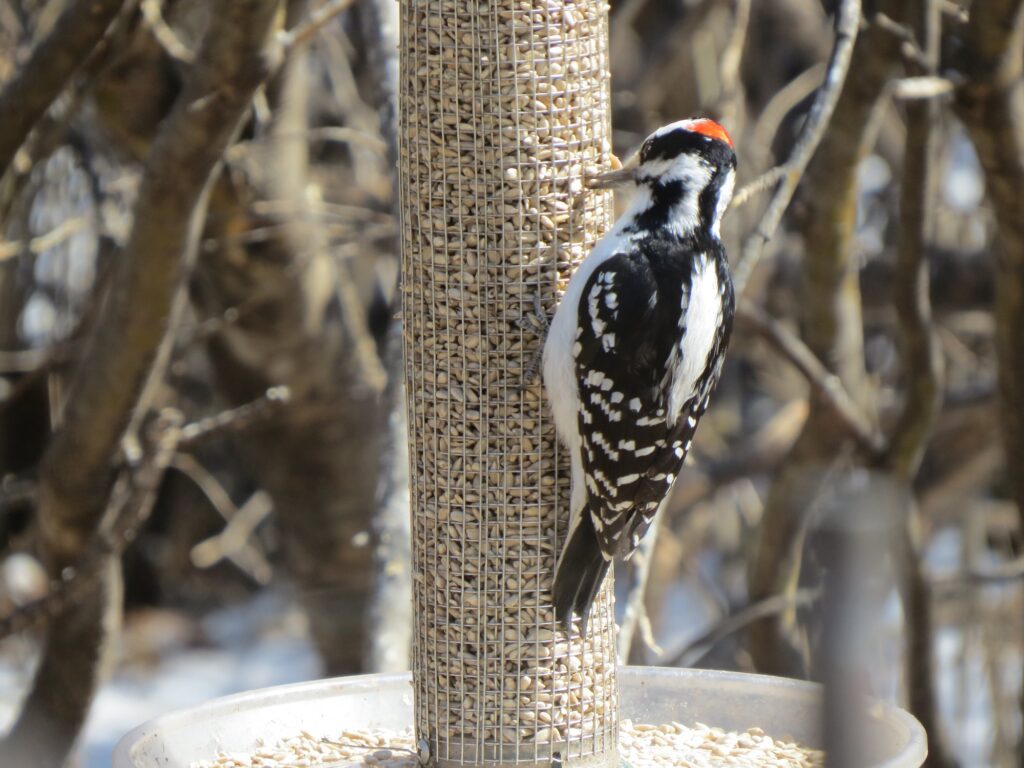Feathered Friends by Sherrie Versluis

One of the most popular and enjoyable birds to attract to the backyard are woodpeckers. These active birds are colourful and entertaining with most species being year-round visitors. They are part of the family Picidae and are found throughout the world excluding a few locales such as New Zealand, Madagascar, and New Guinea. There are over 250 species in this family with less than 20 of them found in Canada which also includes sapsuckers and flickers. The majority of woodpeckers dwell in mature forests and suburban areas and while others are found in desert areas where cacti are their preferred habitat. They can be seen clinging to trees as they search for insects and rarely perch but flickers spend most of their time on the ground.
Woodpeckers range in size from as small as 8 cm in length up to 60 cm for the largest woodpecker in Canada, the amazing Pileated woodpecker. The colors of most woodpeckers are typically black, white, and red although the flickers are brown and some also have yellow in their feathers. Most species have notable patterns to their plumage like barring, speckling, or banded. Of course their most notable trait is the long pointed bill, designed to chisel into the wood of dead trees. Their nostrils are covered by bristle like hairs that protect them from debris as they hammer into the wood. They have unusual feet compared to other birds, 2 toes in the front and 2 in the back although some have 3 toes in the front like the appropriately named, Three-toed woodpecker. This design is to cater to their need to cling to trees. They also have strong tail feathers to help them maintain their balance and to help them propel through the trees.
The diet of woodpeckers is mainly insects and their larvae. If you ever see a woodpecker ‘damaging’ a tree, sadly the damage is already done internally by insects. Woodpeckers have no interest in burrowing into healthy trees. Their purpose is to find the wood-boring insects that damage or even kill our trees. Many trees may appear healthy but once the woodpeckers start their work, it is evident the damage that the insects have already done. They will also eat berries and seeds.
After excavating a cavity in a dead tree, woodpeckers will lay 2-8 eggs during nesting season. No actual nest is constructed and just the wood chips are used as bedding. The young are cared for by both parents and it is a common sight to see the whole family at birdfeeders once the young have fledged.
Woodpeckers contribute to humans more than we may realize. Their consumption of nuisance insects is significant. Bark beetles cause extensive damage to trees and infestations can be catastrophic to large areas with the population of these beetles in the billions. When this happens, woodpeckers are observed in significant numbers in these areas eating the larvae which aids greatly in reducing the beetles numbers. Orchards are often plagued with Codling moths and Hairy woodpeckers are recognized for controlling these outbreaks.
Concussions and other brain injuries are all to common in sports. Woodpeckers have contributed to the science in helping prevent these injuries. When woodpeckers drum on trees, it is recorded at 20 times per second and some may drum 8000-12,000 times a day! The thought of that would give us humans a real headache but why not the woodpeckers? It does get pretty scientific but the basic protection factors include flexible skulls, a special bone called a hyoid bone that surrounds the inside of the skull to protect the brain, and even their beak is designed to absorb some of the impact. This information has been, and continues to be used in designing helmets and other protective gear in sports.
At birdfeeders, woodpeckers can be attracted all year long by offering suet, nuts, and seed cakes. There are suitable types for each season to make them daily visitors. Look for suet that has more nuts than seeds and there are special feeders designed for shelled peanuts to cater to woodpeckers. Seed cakes are compressed blocks of seeds or nuts held together with gelatin and come in various shapes with accompanying feeders, select the more nutty versions and some even have insects which are a great choice! Attracting these entertaining birds is easy and they also help us gardeners out by eating all the nuisance insects we can’t reach!
Sherrie Versluis is an avid birder and owns The Preferred Perch on St. Mary’s Road in St. Vital. Phone: 204-257-3724.


